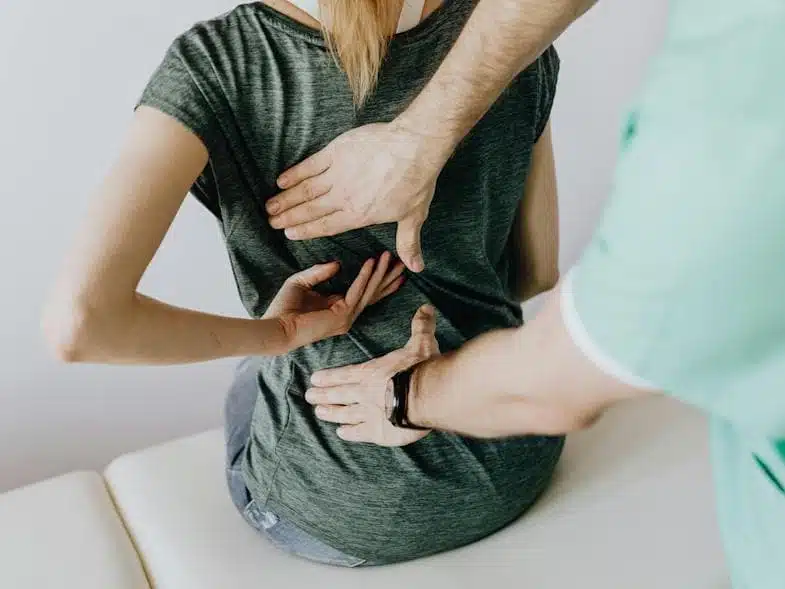If you’re one of the millions of people suffering from back pain, you know how debilitating it can be. From a slight ache to excruciating stabbing sensations, back pain can severely impact your quality of life. But you don’t have to resign yourself to a life of chronic discomfort. By understanding the underlying causes of back pain and exploring proven treatment options, you can take control and find real relief.
What Exactly is Back Pain?
Back pain refers to any pain, tension, or discomfort in the muscles, bones, joints, ligaments, or nerves of the back. It can range from mild to immobilizing and may radiate into other areas like the shoulders, arms, legs, or buttocks. It is an extremely common affliction, affecting up to 80% of adults at some point in their lives.
The back is comprised of the cervical (neck), thoracic (upper and mid back), lumbar (lower back), and sacral (base of the spine) regions. The pain can strike any of these areas for a variety of reasons. It may be acute, lasting less than three months, or chronic if it persists longer. The good news is less than 20% of back pain cases become long-term.
Common Causes of Back Pain?
Back pain stems from problems with the muscles, bones, joints, or nerves of the back. Some common culprits include:
Muscle Strains and Sprains
Repeated heavy lifting, sudden forceful movements, or overstretching can overwork or tear the muscles or ligaments of the back. Muscle tightness or imbalance can also trigger painful spasms. These types of minor injuries account for most acute back pain.
Bulging or Ruptured Discs
The discs between the vertebrae act as cushions or shock absorbers. A disc can rupture or bulge outwards, pressing on nearby nerves and causing inflammation. A herniated disc is a common source of lower back pain and sciatica.
Arthritis
Osteoarthritis of the spine can lead to the breakdown of facet joints between vertebrae. Inflammatory types like rheumatoid arthritis or ankylosing spondylitis also contribute to back discomfort and stiffness. Spinal arthritis narrows the space around nerves, resulting in additional pressure.
Spinal Stenosis
When the hollow column through which the spinal cord travels narrows due to arthritis or disc herniation, it can cramp the cord and nerves. This spinal stenosis often causes cramping leg pain in addition to back problems.
Osteoporosis
Loss of bone density from osteoporosis makes vertebrae porous and prone to painful compression fractures. It’s a major cause of back pain in the elderly.
Other Causes
Less common sources of back discomfort include spinal curvature (scoliosis, kyphosis), pregnancy, infection, tumors, and nerve root compression. Medical problems like kidney stones, ovarian cysts, and prostate issues can also generate back discomfort. Sometimes no definite cause can be found.
What are the Symptoms?
Back pain symptoms can vary greatly depending on the location, severity, and underlying cause. Typical symptoms include:
- Aching, throbbing, stabbing or burning sensations
- Sharp, shooting pain that radiates into the legs, hips, or shoulders
- Muscle tenderness, spasms, cramping or stiffness
- Reduced mobility, range of motion, flexibility
- Numbness or tingling in the back, legs, feet, toes
- Weakness or impaired muscle coordination
- Swelling, redness, warmth around affected area
The specific location of the discomfort provides clues to the origin. Lower back pain often results from muscle or ligament strain. Middle back issues may involve rib injuries, arthritis, or osteoporosis. Upper back problems tend to derive from poor posture, overuse, or muscle tension.
Certain symptoms warrant prompt medical care such as:
- Loss of bowel/bladder function
- Fever, chills, unexplained weight loss
- Sudden severe numbness or weakness
- Back pain after a fall or injury
These red flags may indicate an underlying infection, fracture, or pressing neurological issue requiring emergency spinal decompression. Fortunately, the vast majority of back pain cases aren’t this severe.
Risk Factors
Anyone can experience back pain, even young athletes and children. But these factors boost susceptibility:
- Age – Back pain risk rises beginning around age 30-40.
- Weight – Excess weight overstresses back muscles and joints.
- Lack of Exercise – Weak back muscles are more prone to strain.
- Health Conditions – Arthritis, osteoporosis, scoliosis, and other disorders that affect the back’s structural integrity contribute to pain.
- Psychological Factors – Stress and conditions like depression/anxiety increase muscle tension.
- Occupational Hazards – Jobs involving repetitive bending, lifting, vibration, or sitting boost injury risk.
- Bad Posture & Biomechanics – Slumping, slouching, or improper lifting techniques strain the back.
- Genetics – A family history of back issues slightly raises susceptibility.
Prevention
You can minimize back pain risk and keep your back strong with regular exercise, good posture and movement habits, weight control, and lifestyle measures:
- Core & Back Exercises – Strengthening these muscle groups better supports the spine and absorbs stress. Try bridges, bird dogs, planks, yoga, Pilates.
- Cardiovascular Exercise – Low-impact aerobic workouts improve circulation and muscle tone without undue strain. Walking, swimming, and biking are great choices.
- Stretching & Flexibility Training – Staying limber makes muscles less prone to tears and reduces tension. Focus especially on tight hamstrings, shoulders, and hips.
- Posture Awareness – Reduce spinal load by avoiding slouching and standing up straight. Place one foot on a stool when standing for long periods.
- Proper Lifting Mechanics – Lift heavy objects close to the body using leg power while keeping the back straight. Avoid twisting while handling loads. Enlist help when needed.
- Healthy Weight – Excess pounds tax the back. Losing weight relieves pressure and strain if overweight.
- Managing Stress – Anxiety and worry amplify painful muscle tension. Relaxation practices like meditation help here.
- Choosing Back-Friendly Gear– Use supportive mattresses, ergonomic chairs/workstations, cushioning shoe insoles, lumbar braces, and other items that reduce back strain.
Diagnosis
Figuring out the exact structural cause of back pain is challenging over 50% of the time. Some cases stem from clear-cut injuries, strains, fractures, or age-related degeneration visible on x-rays or advanced imaging.
More often the precise origin remains elusive on scans and tests. Differentiating between potential causes hinges on a detailed history, physical exam, description of symptoms, and knowledge of risk factors. Diagnostic tools that may come into play include:
- Medical History & Physical Exam – Looking for red flags, patterns, location of discomfort/soreness, range of motion, or neurological problems.
- Imaging – X-rays show bone issues like fractures or arthritis. MRIs and CT scans reveal bulging/herniated discs, pinched nerves, tumors and other soft tissue problems.
- Blood Tests – Help diagnose infections, inflammatory arthritis, myeloma, and other conditions.
- Nerve Testing – Measures conduction speed of nerves to check for potential impingement.
- Diskography – Contrast dye injected into discs under x-ray observes shape, tears, leakage. Used to identify discogenic back pain sources prior to surgery.
Treatment Options
Most back pain resolves on its own with simple at-home care within 2-4 weeks. Treatments aim to alleviate discomfort in the short run while addressing any underlying structural problems:
- Rest – Avoid strenuous activity allowing inflamed areas to heal while remaining moderately active.
- Heat/Ice – Alternating applications helps ease muscular pain and swelling.
- Over-the-Counter Medications – Anti-inflammatory drugs (NSAIDs) like ibuprofen or naproxen ease pain and swelling temporarily. Acetaminophen and topicals like lidocaine patches also assist.
- Physical Therapy – Stretches, exercises, ultrasound, and other modalities relax muscles while strengthening the back and core. Helps retrain proper movement patterns.
- Spinal Manipulation – Chiropractors or osteopaths use adjustments and mobilizations to improve spinal joint function and reduce nerve irritation.
- Posture Training – Learning better ergonomics and movement mechanics protects the back from further strain.
- Epidural Steroid Injections – Cortisone shots around irritated nerves calm inflammation.
- Surgery – Last resort for severe disc herniations, spinal stenosis symptoms, or instability failing conservative treatment. Common procedures include laminectomy, discectomy, or spinal fusion.
When to See a Doctor
Most back pain improves with simplistic home remedies, but consult your physician if discomfort:
- Lasts over 1 month without relief
- Progresses, worsens, or spreads
- Causes limb weakness or numbness
- Is accompanied by severe or progressive neurological symptoms
- Results from a fall, accident, or injury
- Happens alongside unexplained weight loss, fever, abdominal pain, etc.
Seeking timely medical care is crucial with red flag symptoms. Early intervention prevents permanent damage from nerve compression, instability, infections, or malignant tumors.
While awaiting appointments, avoid activities aggravating pain. Temporary over-the-counter or prescribed medication combined with ice/heat provides interim relief. Don’t delay if problems worsen or any worrying symptoms appear.
Living with Chronic Back Pain
For roughly 20% of back pain sufferers, discomfort becomes a recurring or constant companion. After exhausting conservative therapies, coping with lifelong pain presents numerous physical and emotional hurdles.
Finding an Integrative Pain Management Plan
Those with intractable pain need a customized combination of treatments including medications, acupuncture, counseling, and relaxation techniques. These holistic plans aim to improve daily function while tackling psychosocial aspects affecting one’s perception of pain.
Exploring Advanced Interventions
Patients who fail basic treatments may undergo specialized injections, implants, or operations. Epidural adhesiolysis breaks up scar tissue around irritated nerves. Spinal cord stimulators utilize electrical signals to interrupt pain. Disc replacement or spinal fusion surgeries reinforce unstable, damaged areas when other options provide insufficient pain relief or disability reduction.
Staying Active & Making Lifestyle Changes
While vigorous activity worsens acute back pain, maintaining physical fitness safely prevents dysfunction in the long run. This strengthens supportive muscles as cardio conditioning fights inflammation. Adjusting movements and posture while finding comfortable sleeping positions ensures back-friendlier daily mechanics. Assistive devices like shoe inserts, mobility aids, or back braces provide extra support.
Addressing the Emotional Aspects
Chronic pain understandably stokes frustration, anger, sadness, anxiety, and depression. Support groups, counseling, stress reduction practices, and drug-free interventions cultivate positive coping strategies. This facilitates acceptance of any permanent limitations or losses stemming from persistent back problems.
Experimenting with Alternative Therapies
Acupuncture, massage, yoga, tai chi, qigong, and other complementary modalities alleviate certain aspects of long-term pain for some individuals. While less studied than medical treatments, these drug-free options aid relaxation while releasing muscle tension. Special diets may assist too. Tracking symptoms helps determine which unconventional therapies deliver noticeable relief.
When to Try Pain Management
If back pain endures over 12 weeks despite rest, physical therapy, medication, injections, or other conservative care, advancing to comprehensive pain management makes sense before reverting to riskier interventions. Using a team approach addresses physical, social, psychological, and emotional contributors to improve quality of life.
Gain Control Over Your Back Pain
While preventing back pain isn’t always possible, understanding fundamentals about typical causes, smart prevention strategies, when to seek help and the range of treatment options available today empowers sufferers. Most back pain cases, including chronic low back pain, resolve quickly with simple measures as described in Rosen’s Emergency Medicine. For more stubborn issues, physical therapy, chiropractic treatment, injections, or surgery provide hope.
Even facing chronic discomfort, integrating self-care with advanced coping techniques makes life with back pain far more manageable. Being proactive lessens agony while restoring confidence that you can overcome this challenge and reclaim an active fulfilling lifestyle. With the right resources and support, managing back pain is within reach.



